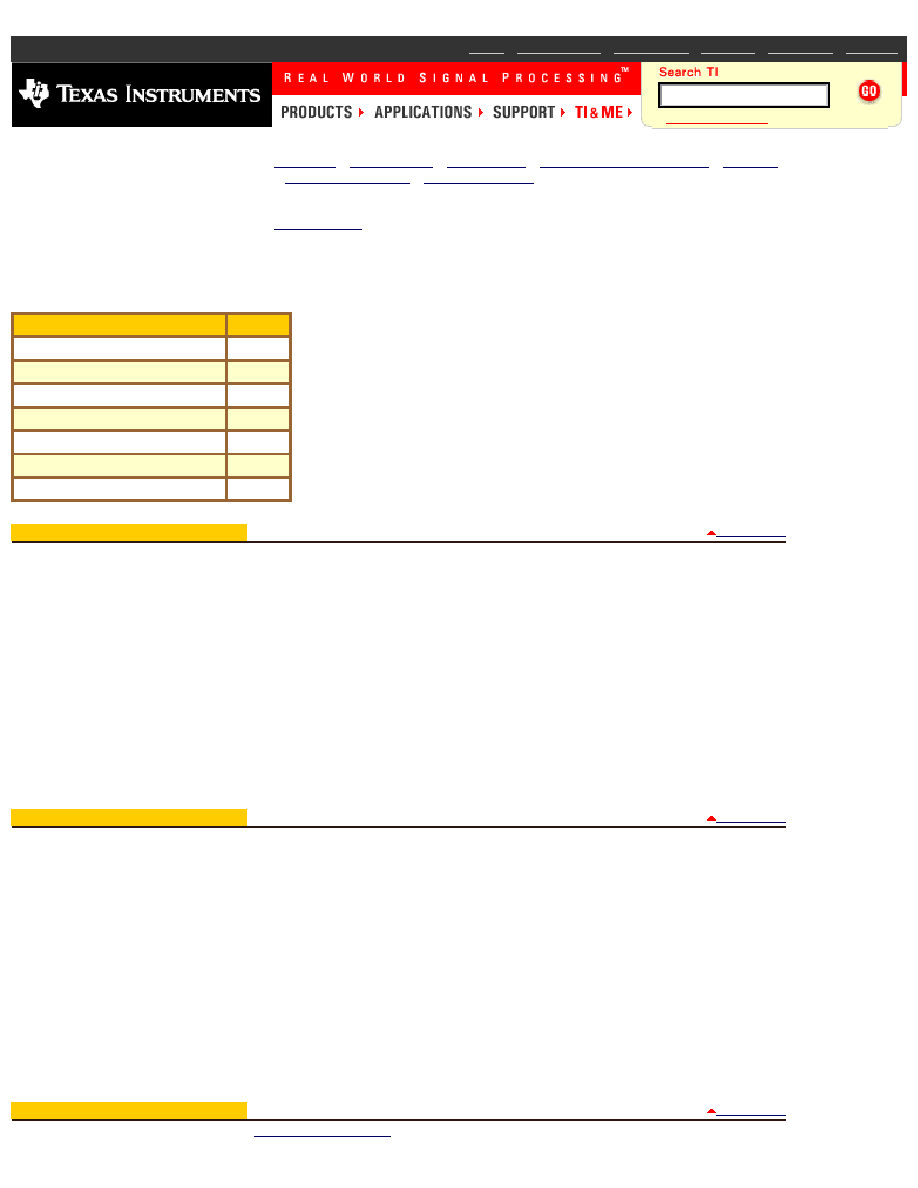- 您現(xiàn)在的位置:買賣IC網(wǎng) > PDF目錄98307 > TWL1103PBSR (TEXAS INSTRUMENTS INC) SPECIALTY CONSUMER CIRCUIT, PQFP32 PDF資料下載
參數(shù)資料
| 型號(hào): | TWL1103PBSR |
| 廠商: | TEXAS INSTRUMENTS INC |
| 元件分類: | 消費(fèi)家電 |
| 英文描述: | SPECIALTY CONSUMER CIRCUIT, PQFP32 |
| 封裝: | PLASTIC, QFP-32 |
| 文件頁數(shù): | 25/32頁 |
| 文件大小: | 476K |
| 代理商: | TWL1103PBSR |
第1頁第2頁第3頁第4頁第5頁第6頁第7頁第8頁第9頁第10頁第11頁第12頁第13頁第14頁第15頁第16頁第17頁第18頁第19頁第20頁第21頁第22頁第23頁第24頁當(dāng)前第25頁第26頁第27頁第28頁第29頁第30頁第31頁第32頁

Product Folder: TWL1103, Voice Band Audio Processor
PRODUCT FOLDER | PRODUCT INFO: FEATURES | DESCRIPTION | DATASHEETS | PRICING/AVAILABILITY/PKG | SAMPLES
PRODUCT SUPPORT: APPLICATIONS
TWL1103, Voice Band Audio Processor
DEVICE STATUS: ACTIVE
PARAMETER NAME
TWL1103
Resolution (Bits)
15
Mic Inputs
2
Speaker Outputs
2
Programming Interface
I2C
Companding
u-, A-law
Internal DTMF/Tones
Yes
Speaker Impedance (min) (Ohms) 16
FEATURES
q
2.7-V Operation
q
Two Differential Microphone Inputs, One Differential Earphone Output, and One Single-Ended Earphone Output
q
Programmable Gain Amplifiers for Transmit, Receive, Sidetone, and Volume Control
q
Earphone Mute and Microphone Mute
q
On-Chip I2C Bus, Which Provides a Simple, Standard, Two-Wire Serial Interface With Digital ICs
q
Programmable for 15-Bit Linear Data or 8-Bit Companded (u-Law or A-Law) Data
q
Available in a 32-Pin Thin Quad Flatpack (TQFP) Package and an 80-Pin GQE MicroStar JuniorTM Ball Grid Array (BGA)
q
Designed for Analog and Digital Wireless Handsets and Telecommunications Applications
q
Dual-Tone Multifrequency (DTMF) and Single Tone Generator
q
Pulse Density Modulated (PDM) Buzzer Output
MicroStar Junior and VBAP are trademarks of Texas Instruments.
All other trademarks are the property of their respective owners.
DESCRIPTION
The voice-band audio processor (VBAP) is designed to perform transmit encoding analog/digital (A/D) conversion, receive
decoding digital/analog (D/A) conversion, and transmit and receive filtering for voice-band communications systems. The
device operates in either the 15-bit linear or 8-bit companded (u-law or A-Law) mode, which is selectable through the I2C
interface. The VBAP generates its own internal clocks from a 2.048-MHz master clock input.
This device contains circuits to protect its inputs and outputs against damage due to high static voltages or electrostatic
fields. These circuits have been qualified to protect this device against electrostatic discharges (ESD) of up to 2 kV according
to MIL-STD-883C, Method 3015; however, it is advised that precautions be taken to avoid application of any voltage higher
than maximum-rated voltages to these high-impedance circuits. During storage or handling, the device leads should be
shorted together or the device should be placed in conductive foam. In a circuit, unused inputs should always be connected
to an appropriated logic voltage level, preferably either VCC or ground. Specific guidelines for handling devices of this type
are contained in the publication Guidelines for Handling Electrostatic-Discharge-Sensitive (ESDS) Devices and Assemblies
available from Texas Instruments.
TECHNICAL RESOURCES
To view the following documents, Acrobat Reader 4.0 is required.
file:///G|/imaging/BITTING/cpl_rework/twl1103.html (1 of 2) [May-09-2002 3:32:45 PM]
相關(guān)PDF資料 |
PDF描述 |
|---|---|
| TWL1103GQER | SPECIALTY CONSUMER CIRCUIT, PBGA80 |
| TWL1103TPBSQ1 | SPECIALTY CONSUMER CIRCUIT, PQFP32 |
| TWL1103TPBSRQ1 | SPECIALTY CONSUMER CIRCUIT, PQFP32 |
| TWL1106PWR | SPECIALTY CONSUMER CIRCUIT, PDSO20 |
| TWL1106PW | SPECIALTY CONSUMER CIRCUIT, PDSO20 |
相關(guān)代理商/技術(shù)參數(shù) |
參數(shù)描述 |
|---|---|
| TWL1103TPBSQ1 | 功能描述:音頻 DSP Auto Cat Voice-Band Audio Processor RoHS:否 制造商:Texas Instruments 工作電源電壓: 電源電流: 工作溫度范圍: 安裝風(fēng)格: 封裝 / 箱體: 封裝:Tube |
| TWL1103TPBSRQ1 | 功能描述:音頻 DSP Auto Cat Voice-Band Audio Processor RoHS:否 制造商:Texas Instruments 工作電源電壓: 電源電流: 工作溫度范圍: 安裝風(fēng)格: 封裝 / 箱體: 封裝:Tube |
| TWL1103T-Q1 | 制造商:未知廠家 制造商全稱:未知廠家 功能描述:Automotive Catalog Voice-Band Audio Processor (VBAP) |
| TWL1106 | 制造商:TI 制造商全稱:Texas Instruments 功能描述:VOICE-BAND AUDIO PROCESSOR (VBAPa?¢) |
| TWL1106PWR | 制造商:Rochester Electronics LLC 功能描述:- Bulk |
發(fā)布緊急采購,3分鐘左右您將得到回復(fù)。